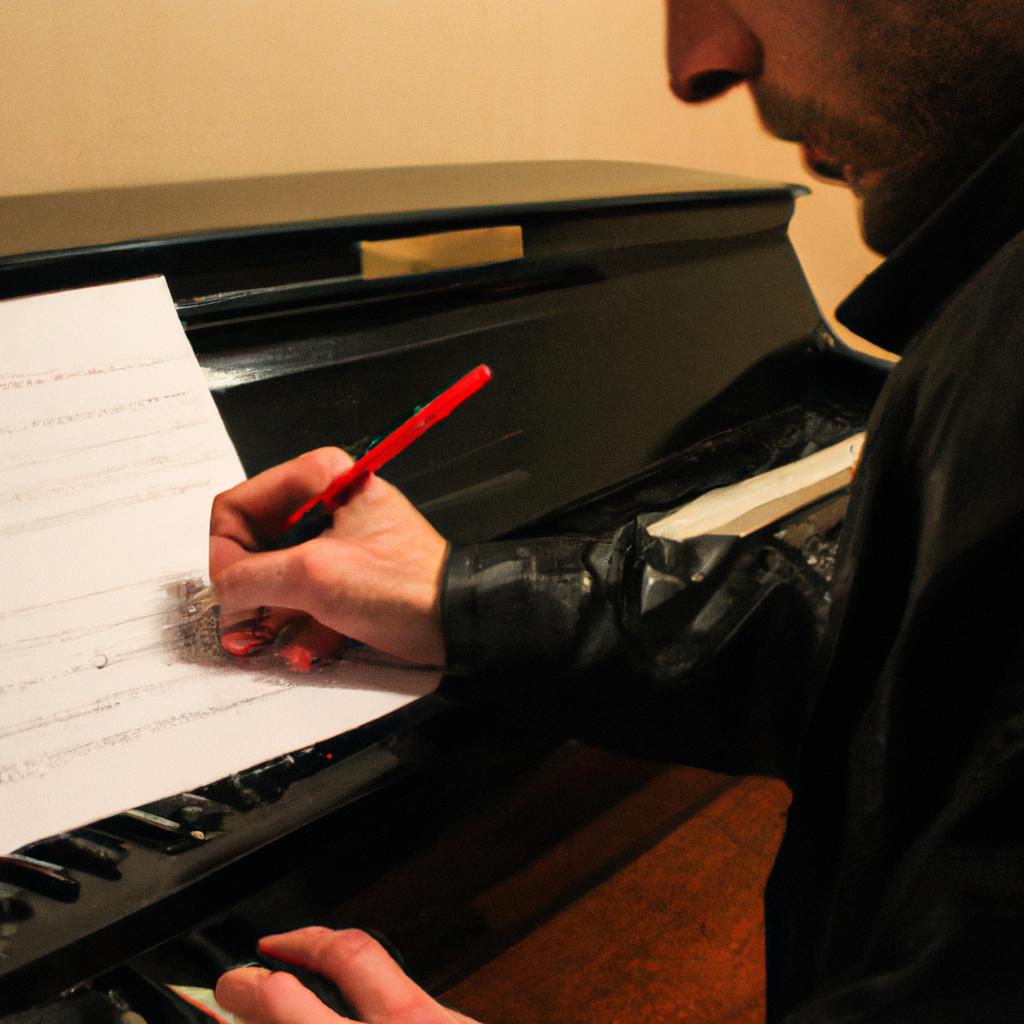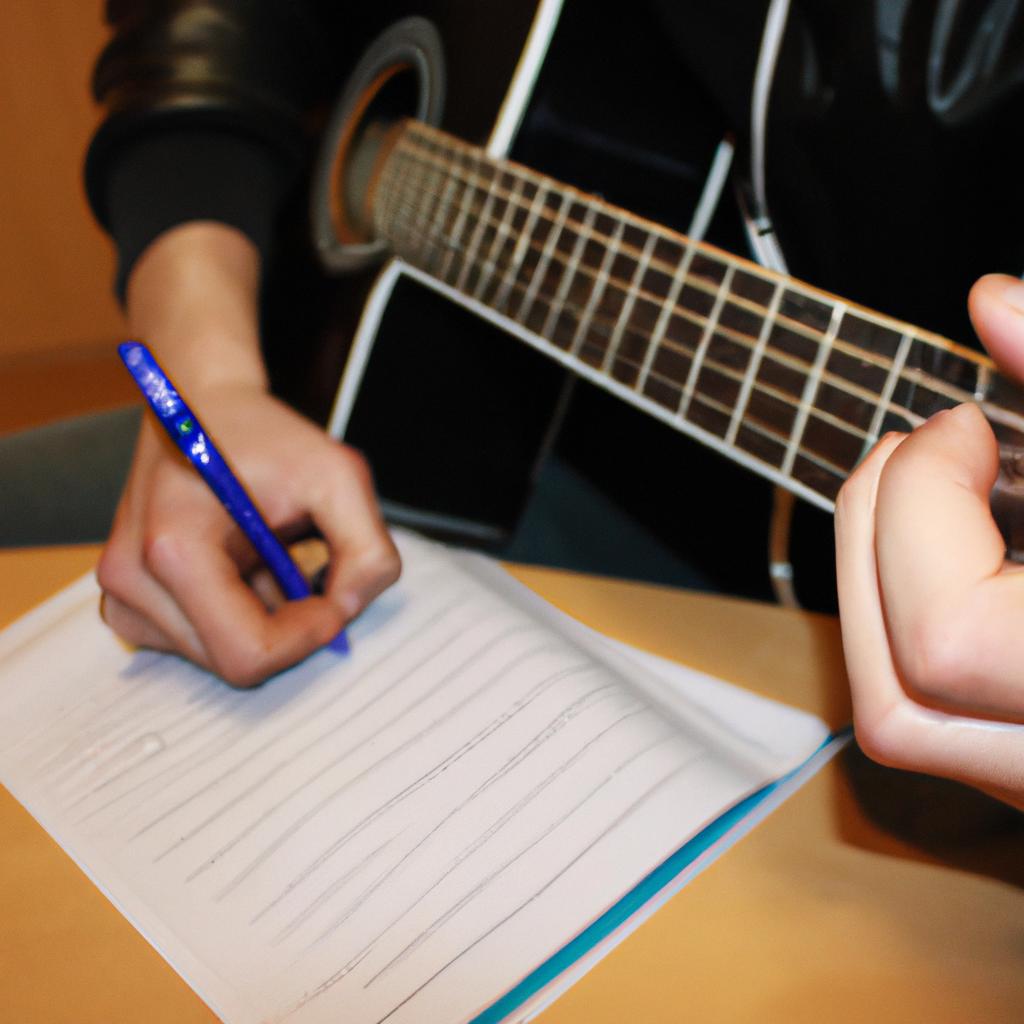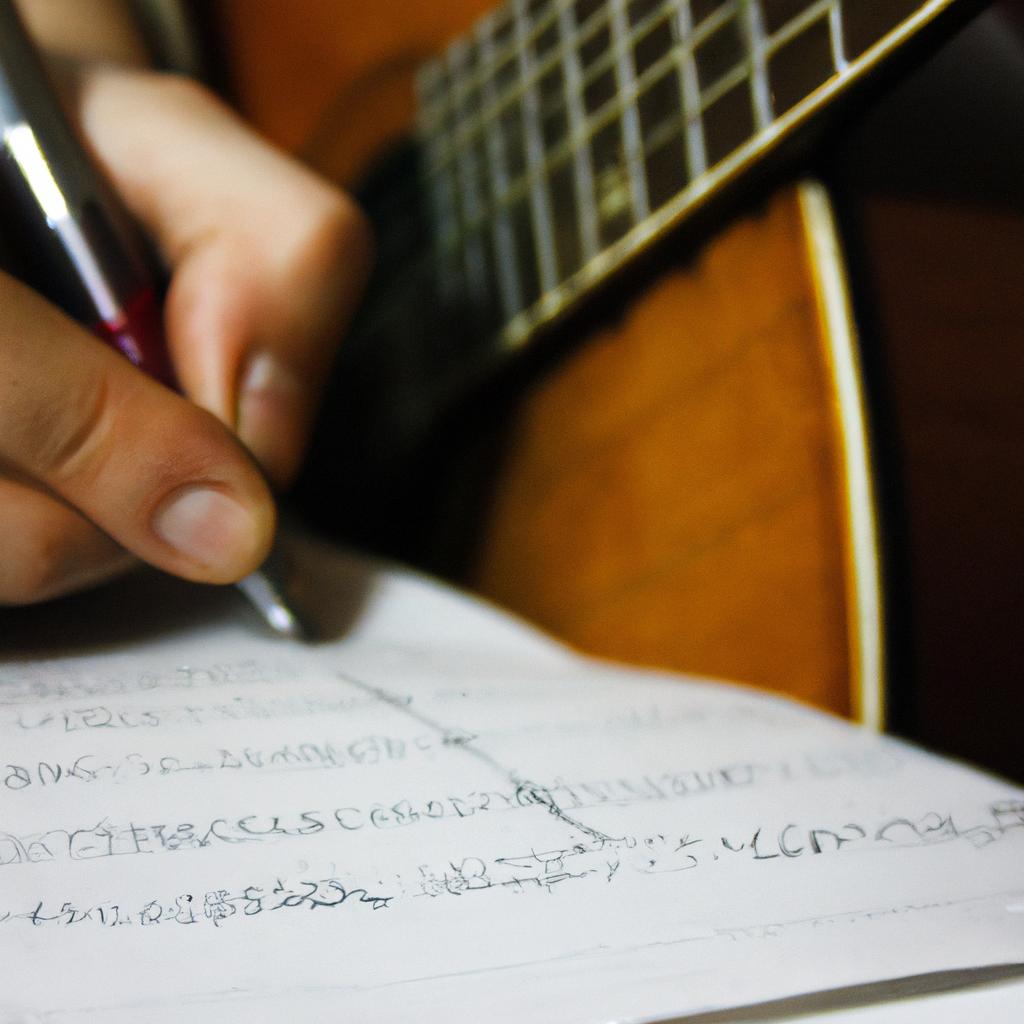Understanding the structure of a song is paramount to comprehending its artistic intent and appreciating the creative prowess behind it. By dissecting the various components that make up a song, listeners can unravel the intricate tapestry woven by composers to convey their message effectively. In this comprehensive guide, we delve into the musical craftsmanship of renowned songwriter Jose Carlos Matos, examining his innovative techniques and unconventional approaches in crafting captivating compositions.
To illustrate the significance of understanding song structure, let us consider an imaginary scenario where a novice musician attempts to compose a heartfelt ballad about unrequited love. Lacking knowledge of song structure, they may struggle with organizing their ideas coherently or fail to evoke the desired emotions through their music. However, armed with a thorough understanding of how different sections such as verses, choruses, bridges, and pre-choruses interact and build upon each other within a song’s framework, musicians like Jose Carlos Matos are able to create compelling narratives that resonate deeply with audiences.
Jose Carlos Matos’ mastery lies not only in his ability to adhere to traditional structures but also in his willingness to challenge them by incorporating unique elements into his compositions. Through analyzing his work closely, aspiring musicians can gain valuable insights into his creative choices concerning melody development, instrumentation, and arrangement. For example, Matos often employs unexpected chord progressions or modulations to add complexity and surprise to his songs. Additionally, he experiments with unconventional song forms, such as using an instrumental interlude in place of a traditional bridge or incorporating a coda at the end of a piece.
Furthermore, Matos demonstrates a keen understanding of dynamics and pacing within his compositions. He knows when to build tension and when to release it, creating moments of catharsis that leave a lasting impact on listeners. By observing how he utilizes techniques like crescendos, decrescendos, and strategic use of silence, musicians can learn how to manipulate the emotional journey their own songs take listeners on.
In terms of lyrics, Jose Carlos Matos showcases his poetic prowess by crafting evocative and thought-provoking verses that seamlessly flow into memorable choruses. His storytelling abilities shine through as he paints vivid imagery with his words and explores universal themes that resonate with people from all walks of life.
By studying Jose Carlos Matos’ innovative approach to songwriting and dissecting the structure of his compositions, aspiring musicians can gain valuable insights into crafting their own captivating music. Understanding how different components interact within a song’s framework allows artists to create cohesive narratives that engage listeners on both intellectual and emotional levels. So whether you’re just starting out or looking to enhance your musical craftsmanship, exploring the work of talented songwriters like Jose Carlos Matos is sure to inspire and elevate your own creative endeavors.
The Importance of Song Structure
When listening to a song, have you ever found yourself captivated by the way it flows seamlessly from one section to another? That captivating flow is no coincidence; it’s the result of meticulous planning and adherence to proper song structure. Understanding song structure is essential for any musician or songwriter looking to create engaging and memorable compositions. In this section, we will explore why song structure matters and how it can elevate the impact of a musical piece.
To illustrate the significance of song structure, let’s consider an example. Imagine a hypothetical song that starts with a catchy verse, followed by an explosive chorus, and then transitions into a mesmerizing bridge before returning to another powerful chorus. This carefully crafted progression keeps listeners engaged throughout the entirety of the composition, building anticipation and delivering moments of emotional intensity at just the right times.
One reason why understanding song structure is crucial lies in its ability to evoke emotions effectively. By following established patterns such as verse-chorus-bridge arrangements, composers tap into our innate familiarity with these structures, allowing us to anticipate certain musical elements and experience heightened emotional responses. For instance, when a familiar chorus kicks in after a contemplative verse, listeners often feel an exhilarating surge of energy and connection with the lyrics.
Consider these key points about song structure:
- It provides coherence: A well-defined structure helps musicians organize their ideas cohesively, ensuring that different sections of a song fit together harmoniously.
- It enhances memorability: Through repetition and variation within specific sections like verses or choruses, songs become more memorable and easier for audiences to connect with emotionally.
- It supports storytelling: An effective song structure can reinforce narrative arcs within music by strategically placing climactic moments or adding dynamic shifts.
- It engages listeners: The predictable yet satisfying nature of structured songs creates a sense of comfort for listeners while also offering surprises through unexpected twists or changes in arrangement.
Let’s delve deeper into the intricacies of song structure by exploring the building blocks of a song: verse and chorus. Understanding how these elements interact will provide further insight into crafting compelling musical compositions.
[Table]As we move forward, let’s explore how verses and choruses work together in creating captivating music.
Verse and Chorus: The Building Blocks of a Song
Understanding Song Structure: A Comprehensive Guide to Jose Carlos Matos’ Music Songwriting
The Importance of Song Structure has been established in the previous section, highlighting its role as a fundamental element in creating memorable and engaging songs. Now, let us delve deeper into one of the most crucial components of song structure – the verse and chorus.
To illustrate this concept, let’s consider an example from Jose Carlos Matos’ music catalog. In his hit single “Echoes of Love,” Matos skillfully employs verse and chorus sections to captivate listeners with a catchy melody and relatable lyrics. The verses tell a story, painting vivid imagery with poetic lines that draw audiences into the narrative. Meanwhile, the chorus serves as the emotional anchor, repeating a melodically strong hook that resonates long after the song ends.
When analyzing the verse and chorus sections within a song’s structure, several key characteristics emerge:
- Contrast: Verses often have lower musical intensity compared to choruses, allowing for variation in dynamics and energy levels.
- Melodic Variation: Choruses frequently feature more memorable melodies or hooks than verses, reinforcing their significance in leaving a lasting impact on listeners.
- Lyrically Distinct: While both sections contribute to storytelling, verses tend to provide more detailed narratives while choruses distill emotions or main ideas into concise phrases or slogans.
- Repetition: Choruses are typically repeated multiple times throughout a song to create familiarity and reinforce its central theme.
These elements can be summarized in the following table:
| Characteristic | Verse | Chorus |
|---|---|---|
| Musical Intensity | Lower | Higher |
| Melodic Variation | Less prominent | Memorable |
| Lyrics | Detailed narration | Emotional essence |
| Repetition | Occasional | Frequent |
By utilizing the verse and chorus sections effectively, songwriters like Jose Carlos Matos can craft a dynamic musical experience that engages listeners on multiple levels. In doing so, they create an emotional journey that resonates with audiences long after the final note fades.
Transitioning seamlessly into our next section about “The Bridge: Adding Depth and Contrast,” we will explore how this distinctive segment enhances songs by introducing new elements to break up repetition and further captivate listeners.
The Bridge: Adding Depth and Contrast
Section Title: The Bridge: Adding Depth and Contrast
In the world of songwriting, the bridge serves as a crucial component that adds depth and contrast to a composition. Just like a literal bridge connects two different places, this section of a song acts as a connection between the verse and chorus, often introducing new musical elements or lyrical themes. To understand its significance, let’s delve deeper into the purpose and structure of the bridge.
One example that exemplifies the power of a well-crafted bridge comes from Jose Carlos Matos’ hit song “Lost in Time.” In this track, the artist skillfully employs a bridge after the second chorus, introducing an unexpected key change accompanied by soaring melodic lines. This shift not only provides variety but also creates anticipation before returning to the final chorus. By incorporating contrasting chords and melodies, Matos effectively captures listeners’ attention and heightens their emotional experience.
The role of the bridge can be further understood through these key points:
- Contrast: The primary function of the bridge is to offer something distinct from both the verse and chorus sections. It presents an opportunity for musicians to experiment with different chord progressions, rhythmic patterns, or instrumentation while maintaining coherence within the overall song structure.
- Lyrically-driven Themes: Bridges often introduce new lyrical content that complements or expands upon existing ideas presented in previous sections. These lyrics may provide additional insight or perspective on the narrative being conveyed in the song.
- Dynamic Shifts: As mentioned earlier, bridges frequently incorporate dynamic shifts such as changes in tempo, volume, or intensity. This helps maintain listener engagement by preventing monotony throughout the entire composition.
- Instrumental Showcases: In some cases, especially in instrumental music genres like jazz or progressive rock, bridges serve as platforms for solo performances or instrumental interplay among band members.
To illustrate these aspects more clearly, consider Table 1 below, which outlines the structural elements commonly found within a bridge section:
Table 1: Structural Elements of a Bridge
| Element | Description |
|---|---|
| Musical Contrast | Introduces new chord progressions or melodic motifs that deviate from the verse and chorus. |
| Lyrical Expansion | Offers additional insight or thematic development beyond what is presented in other sections. |
| Dynamic Shifts | Alters tempo, volume, intensity, or instrumentation to create contrast and maintain interest. |
| Instrumental Focus | Showcases instrumental prowess through solos, interludes, or unique musical arrangements. |
By incorporating these key characteristics into their songwriting process, composers can effectively utilize bridges to add depth and contrast to their compositions.
Transitioning smoothly into the subsequent section about “Pre-Chorus and Post-Chorus: Enhancing the Song’s Dynamics,” we will now explore how these specific components contribute to shaping a song’s overall structure while enhancing its dynamics.
Pre-Chorus and Post-Chorus: Enhancing the Song’s Dynamics
Understanding Song Structure: A Comprehensive Guide to Jose Carlos Matos’ Music Songwriting
In the previous section, we explored how songwriters can enhance their compositions by incorporating a bridge. Now let’s delve further into this important element of song structure and examine its role in adding depth and contrast.
A bridge serves as a transitional section that typically occurs after the second chorus or verse-chorus pattern, introducing new melodies, lyrics, or chord progressions. To illustrate its significance, let’s consider an example from one of Jose Carlos Matos’ songs. In his hit single “Lost in the Moment,” the bridge introduces a soaring guitar solo accompanied by ethereal synthesizers, creating a sense of liberation and emotional intensity.
To fully grasp the impact of bridges on music composition, here are some key points worth noting:
- Contrasting Melodic Content: The bridge often features distinct melodic content that deviates from the main sections of the song. This change provides listeners with a fresh perspective and adds variety to keep them engaged.
- Lyrically Exploring New Themes: Bridges offer an opportunity for songwriters to introduce new lyrical themes or expand upon existing ones. This shift in subject matter can deepen the emotional resonance of a song.
- Dynamic Shifts: By altering elements such as instrumentation, tempo, or volume during the bridge, artists create dynamic shifts that captivate listeners and heighten their emotional response.
- Creating Transitions: Besides providing contrast within a song, bridges also serve as effective transitions between different parts of a composition. They help guide listeners seamlessly through changes in energy levels or musical motifs.
Let’s now turn our attention to understanding the next essential component of song structure – the hook.
Understanding Song Structure: A Comprehensive Guide to Jose Carlos Matos’ Music Songwriting
As we continue our exploration of Jose Carlos Matos’ music songwriting, it is crucial to examine the role of both the pre-chorus and post-chorus sections in enhancing a song’s dynamics. These sections play a vital role in building anticipation and reinforcing the impact of the chorus.
To illustrate their significance, let’s consider an example from one of Matos’ recent releases. In his track “Unbreakable,” the pre-chorus features stripped-down instrumentation accompanied by intimate vocals, setting up a climactic release as the chorus kicks in. Additionally, after each chorus, a catchy post-chorus melody lingers before transitioning back into the verse or another section, leaving listeners craving more.
Here are some key aspects that make pre-choruses and post-choruses impactful:
- Rising Tension: The purpose of a pre-chorus is to build tension and excitement leading up to the chorus. By using different chord progressions or rhythmic patterns than those found in preceding verses, composers create a sense of anticipation.
- Reinforcing Catchiness: Post-choruses often contain repetitive hooks or melodic motifs that reinforce the catchiness of the main chorus. This can serve as an earworm that keeps listeners engaged throughout the entire song.
- Providing Breathing Space: Both pre-choruses and post-choruses offer brief respites between verses and choruses, giving listeners time to absorb previous musical ideas while preparing them for what comes next.
- Enhancing Emotional Impact: Through varying vocal delivery styles or instrumental arrangements, these sections can heighten emotional impact within a song. They act as bridges between contrasting emotions presented in other parts of the composition.
Understanding how to effectively construct pre-choruses and post-choruses allows songwriters like Jose Carlos Matos to craft songs with captivating dynamics that resonate deeply with their audience.
In our subsequent section about “Understanding the Role of the Hook,” we will explore how hooks serve as memorable and often repeated elements that leave a lasting impression on listeners.
Understanding the Role of the Hook
Building upon the enhanced dynamics created by the pre-chorus and post-chorus sections, understanding the role of the hook becomes instrumental in captivating listeners’ attention. By employing catchy melodies or memorable phrases, songwriters can effectively engage their audience and leave a lasting impact. Let us delve deeper into this crucial element of song structure.
The hook serves as the centerpiece of a song, often containing its most recognizable and memorable aspects. Consider, for instance, an imaginary pop track titled “Dreams Come True.” In this hypothetical scenario, the chorus features a compelling hook that repeats throughout the song – “Together we’ll make our dreams come true.” This simple but infectious phrase not only captures attention but also conveys the overarching theme of hope and unity.
To better comprehend how hooks function within songs, let us examine some key characteristics:
- Catchiness: Hooks are designed to be instantly appealing to listeners, with melodic lines that stick in people’s minds long after they have finished listening.
- Memorable Lyrics: Whether through clever wordplay or emotionally charged statements, effective hooks possess lyrics that resonate with audiences on an emotional level.
- Repetition: Consistent repetition allows hooks to become ingrained in listeners’ minds. The repeated exposure increases familiarity and establishes a strong connection between the audience and the song.
- Musical Accompaniment: The musical arrangement accompanying a hook is carefully crafted to enhance its impact. Instrumentation choices such as dynamic chord progressions or rhythmic patterns contribute to its overall catchiness.
Incorporating these elements strategically ensures that hooks leave a significant impression on listeners. To illustrate further, consider the following table showcasing famous songs along with their notable hooks:
| Song Title | Notable Hook |
|---|---|
| “Billie Jean” | “Billie Jean is not my lover” |
| “Bohemian Rhapsody” | “Mama, just killed a man” |
| “I Will Always Love You” | “And I-eee-I will always love you” |
| “Hey Jude” | “Hey Jude, don’t make it bad. Take a sad song and make it better.” |
As we have seen, hooks possess the power to captivate audiences through their catchy melodies and memorable lyrics. By understanding how these elements work together harmoniously, songwriters can effectively engage listeners on an emotional level.
[Exploring Different Song Structures]Exploring Different Song Structures
Understanding Song Structure: A Comprehensive Guide to Jose Carlos Matos’ Music Songwriting
Section 2: Exploring Different Song Structures
In the previous section, we delved into the role of the hook in songwriting, highlighting its significance in capturing listeners’ attention and creating a memorable musical experience. Now, let us venture further by exploring different song structures that Jose Carlos Matos employs in his music.
To illustrate this exploration, let’s take an example from one of Matos’ popular songs titled “Echoes of Time.” This track showcases a unique blend of verse-chorus structure with elements of a bridge. The verses set the narrative foundation through introspective lyrics accompanied by gentle guitar strums, while the chorus amplifies emotional intensity with soaring vocals and layered instrumentation. In between these sections lies a compelling bridge that offers contrasting melodies and powerful lyrical imagery before leading back to the final chorus.
When it comes to crafting their compositions, songwriters like Jose Carlos Matos often experiment with various structural approaches. Here are some common song structures they may employ:
- Verse-Chorus: This classic structure intertwines recurring verses with a catchy chorus that serves as the centerpiece of the song.
- AABA Form: Popularized in jazz standards, this structure consists of two contrasting sections (A) followed by a bridge (B), which adds variety to the overall arrangement.
- ABABCB: With alternating sections throughout the song, this structure allows for dynamic storytelling and diverse melodic progressions.
- Freeform/Experimental: Some artists break away from traditional structures altogether, opting for more unconventional arrangements where each section flows unpredictably into another.
- Verse-Chorus creates familiarity and catchiness
- AABA Form generates anticipation and resolution
- ABABCB builds tension and release
- Freeform/Experimental encourages curiosity and surprise
Furthermore, to deepen our understanding of these emotional responses, let’s consider the following three-column table:
| Song Structure | Emotional Response |
|---|---|
| Verse-Chorus | Familiarity |
| AABA Form | Anticipation |
| ABABCB | Tension |
| Freeform/Experimental | Curiosity |
Through this exploration of diverse song structures, we witness how Jose Carlos Matos skillfully employs different frameworks in his music. By incorporating various structural elements, artists can effectively engage their listeners on an emotional level.
In summary, by examining a specific example from Jose Carlos Matos’ repertoire and exploring common song structures, we gain insight into the versatility of songwriting techniques. Understanding and utilizing different structures allows musicians to evoke distinct emotions within their audience, fostering a deeper connection between artist and listener.
 Jose Carlos Matos
Jose Carlos Matos



